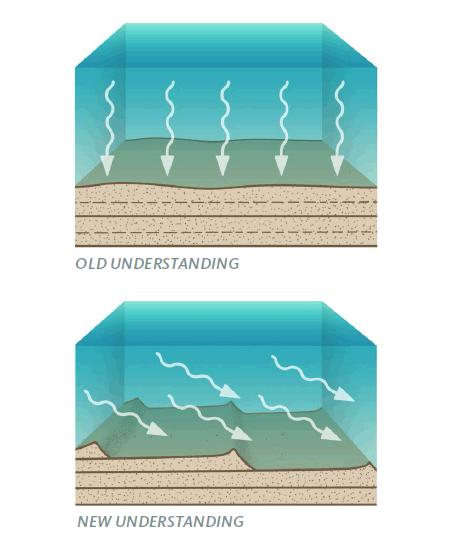Mudrocks in Minutes
Conventional wisdom assumes the mud in earth’s mudrocks took millions of years to settle. New experiments suggest a better idea.
Just about everyone has had fun playing in mud at some time in life. As a child, I liked to play with muddy water too. I’d scoop up a bucket of the water and watch all the fine mud particles that were suspended in the water slowly sink to the bottom. It sometimes took days.
I remember when my teacher had me do an experiment in class as a child. I noticed another thing. We put a large amount of water and dirt (a mixture of mud, silt, and sand) into a glass jar, shook it up, and watched how the different dirt particles settled. The larger sand particles fell rapidly to the bottom, followed by the smaller and slower particles (which I learned were called silt). But the fine mud particles stayed suspended in the water for many hours before finally settling on the bottom, on top of the sand and silt layers.
As a nine-year-old would-be geologist, it made sense to me that gravity explained all this. After all, the larger sand particles are heavier, and so they sink faster than the fine mud particles, which are not so heavy.
Later I learned another reason that mud particles take so long to settle to the bottom. They are often made up of clay minerals, which tend to be thin, flat crystals that float like snowflakes and can stay suspended for a very long time.
When I got older and went to geology class, these observations presented a problem for my biblical way of thinking that the earth is just a few thousand years old. The planet has many thick rock layers—sometimes hundreds of feet thick—made of mud, called mudstones or shales. In conventional thinking, which is based on the belief that the present is the key to understanding the past, wouldn’t it take millions of years for such mudrocks to form?
Rethinking Mud
In my university class, we were taught that it took many hours to deposit a mud layer a tiny fraction of an inch thick. Yet we learned that the Bright Angel Shale exposed in the Grand Canyon is up to 500 feet thick, and the Marcellus Shale underground in eastern Ohio, Pennsylvania, and New York, is up to 900 feet thick. My teachers explained that it must have taken millions of years for these muds to settle out of water and be deposited in those layers.
Now multiply that by all the different mudrock layers in the geologic record, which are more common than any other type of rock layers (for example, limestones and sandstones). No wonder evolutionary geologists believe the geologic record took hundreds of millions of years to accumulate! That’s why they scoff at biblical creationists who say that many of these mudrock layers were deposited all at once in the yearlong, global Genesis flood.
Then, in 2007, the millions-of-years story got turned on its head. Carefully conducted experiments showed how mud particles could fall quickly through rapidly moving water. Nobody had thought to test that before.
I suspected that there had to be a way for mud to settle quickly, but I didn’t have a specific answer. Yet I knew that God’s Word is infallible, and I’d seen science “catch up” many times as fallible scientists discovered something they didn’t know before.
Then, in 2007, the millions-of-years story got turned on its head. Carefully conducted experiments showed how mud particles could fall quickly through rapidly moving water. Nobody had thought to test that before.
Geoscientists used a special kind of instrument called a racetrack flume at Indiana University in Bloomington. A normal flume looks like a very long, narrow glass aquarium. Researchers dump sediments in one end and release water to surge over those sediments. The geoscientists then watch to see how the water deposits the sediments downflow. Normally a flume is very long and straight, but a racetrack flume goes in a circle. So when the water is released, it flows around and around in a large circle and accelerates as it goes. As a result, the water flows much faster than in a long, straight flume.
The geoscientists discovered that the fast-moving mud particles were deposited very rapidly—at the same speed that sand grains are deposited. Even I was surprised.
Upon further investigation, they discovered that mud particles in the rapidly moving water stick together to form large clumps, about the size of sand grains. The technical term for the process is “flocculation.” The clumps (floccules), containing as many as half a million tiny mud particle “plates,” end up behaving like large sand grains.
When they looked further into this mystery, the scientists understood how the mud particles stuck together. The minerals have residual weak electric charges on the surfaces of their crystalline structures. In the rapidly moving water, these tiny plates are forced so close to one another that the weak opposite charges attract.
What do you know? Science again caught up with the Bible. These stunning results were reported in Science, the leading weekly science journal.1 In the same issue, two other geoscientists commented that this “mechanism for depositing muds is at odds with perceived wisdom.”2 They admitted that the science of mud accumulation was “poised for a paradigm shift.”
We used to think of mud forming slowly as it settled from the top, falling down one layer at a time, in standing water. Now we know that many layers form instantly at the same time, from water flowing horizontally, under “high-energy” conditions (see diagram).

How Rock Layers Form Sideways
If you scoop up a bucket of muddy, sandy water, the larger sand particles settle to the bottom first, and then the mud. Geologists assumed this is how the earth’s rock layers formed, slowly over millions of years.
Then a 2007 experiment with rapidly moving water in a flume showed that mud particles clump and are deposited at the same rapid rate as sand, in multiple layers, as the water flows sideways. That’s exactly what would have happened during the yearlong flood, which destroyed the earth under water.
Astounding! If mudrocks “make up the majority of the geological record,” as these geoscientists already say, then most of them could have been deposited rapidly during the yearlong global flood cataclysm.
This reminds me of the wisdom of Solomon: “The one who states his case first seems right, until the other comes and examines him
” (Proverbs 18:17). It also reminds me of another favorite, that a child who simply trusts God will be wiser than all his teachers (Psalm 119:99).
Answers Magazine
May–June 2018
All our lives we’ve heard that caves form slowly, over tens of thousands of years. But recent discoveries are turning old assumptions upside down.
Browse IssueFootnotes
- Juergen Schieber, John Southard, and Kevin Thaisen, “Accretion of Mudstone Beds from Migrating Floccule Ripples”, Science 318 pp. 1760-1763, 14 December 2007.
- Joe H.S. Masquaker and Kevin M. Bohacs, “On the Accumulation of Mud”, Science 318 pp. 1734-1735, 14 December 2007.

Answers in Genesis is an apologetics ministry, dedicated to helping Christians defend their faith and proclaim the good news of Jesus Christ.
- Customer Service 800.778.3390
- Available Monday–Friday | 9 AM–5 PM ET
- © 2026 Answers in Genesis



